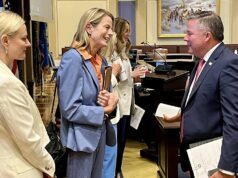[Editor’s note: An additional subsection was added to the bottom of this article on March 1 per the author’s request.]
Oklahoma has always had a surplus of weird paradoxes. We exhibit so many contradictions that even the most important of them can get overlooked.
For instance, how is it that Oklahoma is praised nationally for taking the lead in high-quality preschool even as we have starved our traditional public schools?
It is a tribute to whatever it is in Oklahoma culture that produced a grassroots campaign for universal pre-kindergarten that, subsequently, has earned many accolades. The highly respected American Education Research Association (AERA) recognized these pioneering efforts during one of its centennial celebration lectures Feb. 22 at the Oklahoma History Center.
Among some of the greatest early education experts and political leaders, UCLA’s Deborah Lowe Vandell delivered the keynote address. In it, she reviewed the public’s strong support for early childhood education and its excellent record of improving the lives of children. She also noted the recent pushback by some in terms of scaling up high-quality programs.
Early ed by the numbers
As Vandell explained, up to 90 percent of the public supports early education. Few parents would oppose high-quality services for their own kids. In the Midwest, parents with two children in paid childcare invest an average of $17,733 per year for it.
She went on to say that 5.3 million children attend preschool programs their parents pay for, but only 2.4 million kids attend Head Start and other state- and district-funded pre-k. Moreover, 90 percent of 4-year-olds in families that are in the top quintile of family income attend high-quality programs. Meanwhile, only 64 percent of children from families in the bottom-two quintiles attend high-quality programs.
A major part of this gap is due to disparities in teacher quality. The average childcare worker earns less than $10 per hour. Their salaries have been stagnant since 1997, so they are in the bottom 3 percentile of workers’ wages. Similarly, the average preschool teacher earns less than $15 per hour, which is in the bottom 19 percentile of workers’ wages.
Gains fade due to flaws after early education
Vandell hit on a major issue when explaining why early education gains sometimes fade during primary schools. Coincidentally, a Washington Post commentary recently bemoaned the “fadeout” of early education gains during elementary school.
The title, Preschool can provide a boost, but the gains can fade surprisingly fast, and the first part of the article were examples of describing the glass as half-empty as opposed to half-full. However, the second half of the commentary (whose authors Drew Bailey, Greg Duncan and Candice Odgers are also well-respected researchers) aligns with Vandell’s conclusion.
As Vandell explained, extensive research documents the strong short-term gains produced by preschool, but the benefits appear mixed in the medium-term. We find the strongest benefits, however, in the long-term, including improved health and graduation rates.
The authors of the WaPo article write almost the same thing:
A handful of the most rigorously implemented and evaluated programs appear to produce benefits that persist well into adulthood: Participants graduate from high school at a higher rate, earn more, have fewer run-ins with the law and lead healthier lives than peers from similar backgrounds.
My take is that Bailey et. al’s commentary reveals more about the flaws in our public school system than it does early education. Sounding like Vandell, they note, “What holds disadvantaged kids back throughout their schooling is not a failure to master the basics,” and conclude:
American children raised in poverty must wade through a stream of stresses. They may have to move often or even be homeless for a time. They may be exposed to violence in their homes or neighborhoods. … When children grow up in challenging home environments and move through mediocre classrooms, it’s not surprising that they are unable to translate early gains in basic math and reading skills into mastery of more advanced skills such as fractions, algebra or critical reading.
And that brings us back to the Oklahoma dilemma: Children receive a great start with universal pre-k, but it’s a mistake to believe those “initial gains will sustain themselves,” as the WaPo article puts it.
Early ed successes should be integrated upward
Oklahoma must extend the lessons from our early education successes into other social-service institutions and traditional public schools. Preschool programs must share their successes with primary school teachers. We must learn the lessons of home-visitation programs that help nurture more constructive parent-child interactions. Meanwhile, older children need more intensive interventions to help master advanced skills. We must invest in secondary schools with small learning communities as well as in high-quality career tech.
Strange as it sounds, our state could become a pioneer in holistic education. Oklahomans have helped lead the grassroots backlash against teach-to-the-test basic skills instruction. We could integrate the principles of our high-quality early education into our struggling elementary and secondary schools.
Or should I say that we could build on our successes if we persuaded our Legislature to fund the comprehensive solutions that Oklahomans have helped invent?
Update: March 1, 2017
A local early education expert sent me a link to some recent Washington Post letters to the editor. The letters criticize Bailey et al’s WaPo article from Feb. 19 about the fade out of gains from early education.
In the first letter, the executive director of the National Head Start Association asserted that “fadeout is a myth” and cited a study that “found that fadeout happens when children move into low-performing K-12 schools, but not when they proceed to high-performing schools.”
The toughest criticism was issued by Nobel laureate James Heckman, who attended Harding High School in OKC. Heckman wrote that Bailey et al’s study “ignores an overwhelming body of recent evidence documenting that so-called fadeout doesn’t exist.






















